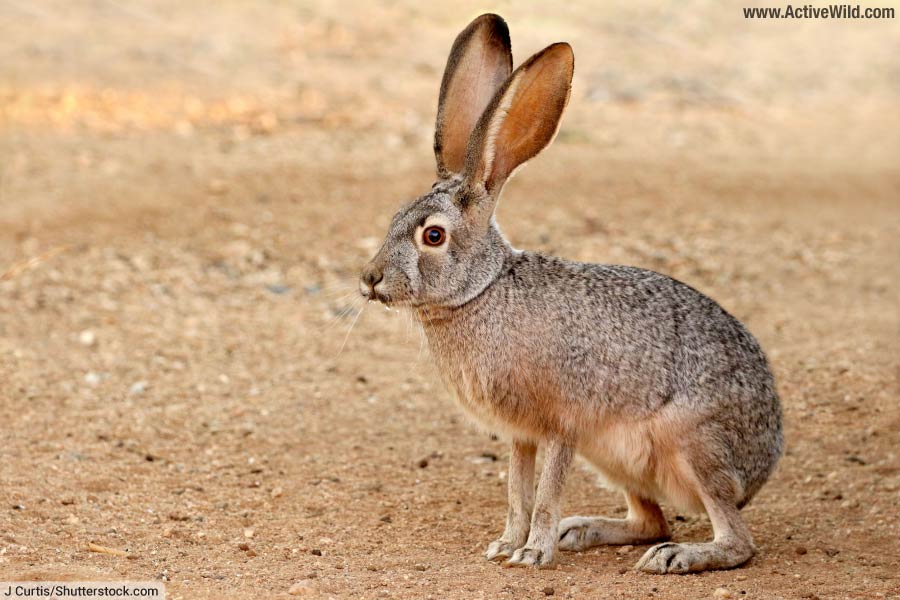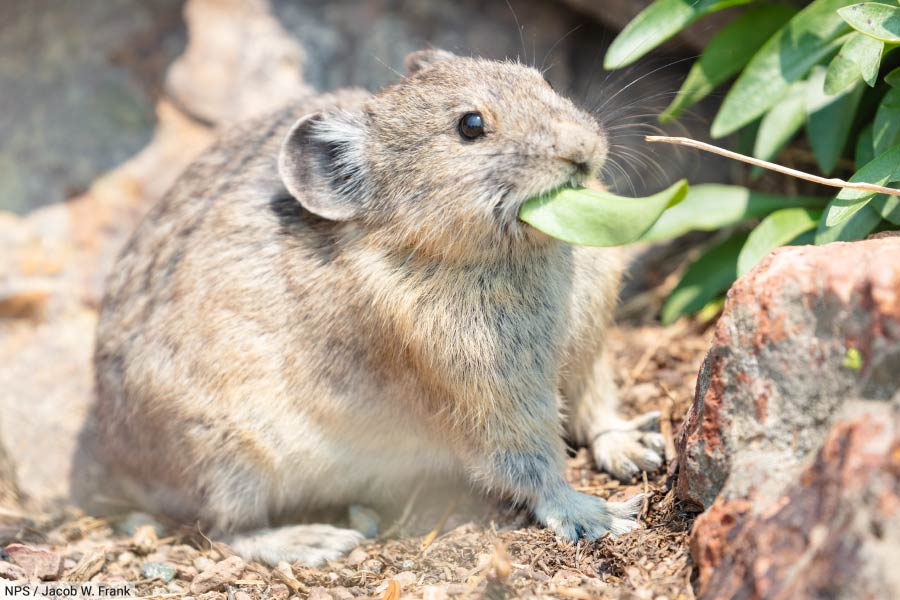On this page, you'll find out if rabbits are rodents – plus many other interesting facts on rabbits and their closest relatives, hares and pikas.
Page Index
- Are Rabbits Rodents?
- Lagomorphs
- Are Rabbits And Rodents Related?
- Lagomorph Families
- Characteristics Of Lagomorphs
- Rabbits Vs Rodents
- Similarities Between Lagomorphs & Rodents
- Differences Between Rabbits And Picas
- Conclusion And Further Reading
Related Pages on Active Wild
- You can find out more about rodents on this page: Rodents - The Ultimate Guide
- Discover more about animals on this page: Animals - A Complete Guide To The Animal Kingdom
Are Rabbits Rodents?

Rabbits are not rodents; they belong to a different order of mammals: Lagomorpha, which is also home to hares and pikas. Although there are some similarities between lagomorphs and rodents – both are gnawing animals with sharp, continuously-growing incisor teeth – numerous physical and behavioral differences separate the groups.
A key difference between rabbits (and other lagomorphs) and rodents is that lagomorphs possess four incisor teeth in the upper jaw compared to the two found in rodents. Rabbits also tend to be larger on average than (most) rodents.
Rodents are are members of the order Rodentia. Examples of rodents include animals such as mice, rats, voles, squirrels and beavers. You can find out more about rodents on this page: Rodents.
Read on to find out the key differences and similarities between rabbits and rodents…
Lagomorphs

Rabbits belong to the order Lagomorpha, a group of mammals that is also home to hares and pikas. Members of this group are known as Lagomorphs.

Lagomorphs are herbivores and are found on all continents except Antarctica – although they are not native to Australia, having been introduced to the continent by humans.

One key distinguishing feature of lagomorphs is their double set of upper incisors, designed for gnawing and chewing. These continue to grow throughout the animal’s lifetime, and are an adaptation for eating tough plant material – a rabbit’s teeth will never wear down.
Lagomorphs also have large, powerful hind legs adapted for quick movement to evade predators, and many species are known for their ability to reproduce rapidly.

Are Rabbits And Rodents Related?

At one time, rabbits and other lagomorphs were classified as rodents, but today they are placed in separate orders.
Rabbits, along with hares and pikas, make up the order Lagomorpha, whereas rodents form the order Rodentia.
You can find out more about terms such as "order" and "family" on this page: Animals - A Complete Guide
The relationship between lagomorphs and rodents has been much-debated over the years. Recent research suggests that lagomorphs and rodents are more closely related to each other than they are to other mammals, and that together they make up the clade Glires (a clade is a branch of the animal kingdom family tree).
In terms of numbers of species, Rodentia is a far larger group than Lagomorpha. The catalogue of life (a worldwide database of species) currently lists 2,339 living rodent species (source), compared to 98 living lagomorph species (source). (Figures obtained June 2023)
Rodentia is the largest mammalian order; around 40% of all mammals are rodents!
Lagomorph Families
The order Lagomorpha contains just two families: Leporidae (rabbits and hares) and Ochotonidae (pikas).
Leporidae contains 68 species (source); Ochotonidae contains 30 species (source).
Rabbits and hares have long hind legs and long ears, and live in a variety of habitats. There is less difference in the lengths of a pika’s front and hind legs, and they are typically found in rocky, mountainous habitats.
You can find out more about the differences between rabbits and pikas further down the page.
Rabbits Vs Rodents

While lagomorphs and rodents belong to different orders, they do share a number of similarities due to some similar ecological roles and environmental pressures. Below is a comparison of the two groups.
Similarities Between Lagomorphs & Rodents
- Continuously Growing Incisors: Both rodents and lagomorphs possess incisor teeth that grow continuously throughout their lives, a feature that enables these animals to gnaw persistently without wearing down their teeth.
- No Canine Teeth: neither lagomorphs nor rodents have canine teeth.
- Gap Between Incisors and Molars: both lagomorphs are rodents have a gap, or diastema, between their incisors and their cheek teeth. This allows the skin of the lips to form a barrier between the incisors and the molars, preventing unwanted material from entering the mouth while the animal is gnawing.
- Herbivorous Diets: Many members of both groups are herbivores, meaning they primarily eat plant matter. (Rodents, however, tend to be more omnivorous than lagomorphs.)
- High Reproductive Rates: Both rodents and lagomorphs are known for their high reproductive rates. This characteristic is often a response to high predation rates and a strategy for survival.
- Adaptations for Escaping Predators: Many rodents and lagomorphs have powerful hind legs for quick movements and escaping predators, as well as eyes on the sides of their heads for a wide field of vision.
- Diversity and Global Distribution: Both rodents and lagomorphs are widely distributed across the globe and occupy a variety of habitats.
- Social Behavior: Many species in both groups demonstrate social behaviors, living in groups and demonstrating complex interaction dynamics.
Differences Between Lagomorphs & Rodents
While rodents and lagomorphs share some similarities, there are significant differences between these two groups of mammals that have led to their classification into separate orders. Here are some of the key differences:
- Number of Upper Incisors: Rodents have one pair of upper incisors, whereas lagomorphs have two pairs. The second pair in lagomorphs is smaller and located directly behind the first.
- Diet: While both groups are generally herbivorous, rodents have a broader diet, with some species being omnivores or even predators. Lagomorphs, on the other hand, are strict herbivores.
- Tail Length: Many rodents have long, sometimes prehensile tails, which they use for a variety of functions including balance and communication. Lagomorphs, on the other hand, have much shorter tails.
- Coprophagy: While some rodents practice coprophagy (consumption of feces), it is far more common and pronounced in lagomorphs, where it is an essential part of their digestive process to extract as much nutrition as possible from food.
- Furry Feet: Lagomorphs lack paw pads, and the soles of their feet are covered with fur.
Differences Between Rabbits And Picas
The order Lagomorpha consists of two families: Leporidae and Ochotonidae. Leporidae includes rabbits and hares, while Ochotonidae is made up of pikas. Here are some of the key differences between these two families:
- Size and Body Shape: Leporids, including rabbits and hares, tend to be larger and have longer ears and legs than pikas. Pikas are typically smaller, more rounded, and have short limbs.
- Habitat: Leporids inhabit a variety of environments including forests, grasslands, and deserts around the world, with different species having different specific habitats. On the other hand, pikas are usually found in rocky mountainous areas in Asia, North America, and parts of Eastern Europe.
- Behavior: Rabbits and hares are known for their speed and jumping ability when escaping from predators. Rabbits typically dig burrows for shelter, whereas pikas typically live in crevices among rocks and are known for their 'haystacking' or ‘haypiling’ behavior, where they collect vegetation to store for winter.
- Vocalization: Pikas are known for their loud, distinctive calls, used to communicate warnings to others in their colony. While rabbits and hares can make a variety of sounds, they are generally quieter than pikas.
- Ears and Tail: Rabbits and hares have long ears which can rotate to catch sound from all directions and a tail which can vary in size between species. Pikas have rounded ears and virtually no tail.
Conclusion
Rabbits are not considered to be rodents, as they belong to a separate order: Lagomorpha, which also contains a rabbit’s closest relatives, the hares, as well as the mountain-dwelling pikas. While there are similarities between members of Lagomorpha and Rodentia – all have continuously-growing incisor teeth for gnawing, for example – millions of years of evolution and numerous physical and behavioral differences separate the groups.
You can find out more about rodents on this page: Rodents - The Ultimate Guide
Discover more about animals on this page: Animals - A Complete Guide To The Animal Kingdom


